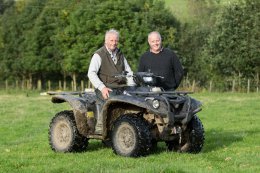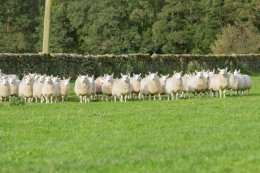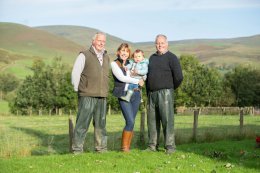
Hoghill
Elliot & Neil Cavers

South Country Cheviots are priority for the Cavers family
HILL sheep farming is a challenging business when fighting against harsh weather conditions, long winters and high input costs, with no guarantee of financial support, but it is possible with skill, determination and, of course, the right type of sheep, and for twin brothers, Neil and Elliot Cavers, there is only one – the South Country Cheviot.
But then, you wouldn’t expect anything else, as the brothers, and their father, Tom, who is still an integral part of the business, have years of experience in breeding and working with the trusty Southie, with the twins having left school at 15 to work on the family unit in Hawick, before moving to farm 1400 acres at Sorbie. In 2001, the brothers took on the tenancy at Hoghill, before then taking on the tenancy at Murtholm, six years ago, and that now totals 3000 acres across three units in the scenic rolling hills of the Ewes Valley and Langholm. Each year, the Cavers produce quality store, prime and breeding stock which regularly command a price in the marketplace when lambs and draft ewes are sold through C and D Auction’s Longtown centre and shearlings at the annual sale at Harrison and Hetherington’s Lockerbie mart.
What’s more impressive, though, is that all four flocks in the business, to include 1100 Cheviots, 540 Blackfaces, 350 Texel cross Cheviots and 25 pure Beltex, are made up of home-bred females, while only a couple of Cheviot tups are bought in each year. Included in these numbers are 200 Cheviots which are crossed with Beltex and Texel tups to breed replacement in-by ewes.
“There is no comparison to the Southie – she’s an easy kept ewe that has the ability to survive on poor ground, yet can still produce a decent lamb which can be sold store or fat,” began Elliot, who is based at Murtholm with wife, Aileen, son, Alasdair, who works full-time at Murtholm, younger son, Sandy, and daughter, Rhea.
“The breed has improved over the years as the sheep now have more stretch and bigger frames compared to days gone by when they were too dumpy.
“They’re easily lambed too, as this year there were only four ewes out a group of 140 at Murtholm which needed attention and they survived entirely on blocks from the beginning of February onwards.”
Stock Ewes at Hoghill

Neil, who lives at Hoghill with wife, Elaine, and his three children; twins, Katherine and Lauren, and son, Glen, added: “For anybody who is looking for a hill breed, the Cheviot takes a bit of beating and they don’t require the amount of feeding that other breeds do. You can run two Southies to the price of one Northie.”
While all lambs are usually finished inside and sold from the end of August onwards, this year, the Cavers are aiming to cut costs and make more shed space by selling more of the lambs as stores. In previous years, lambs were sold direct to the slaughterhouse, but with Longtown mart only a 20-minute drive away, the boys have the sale ring to their advantage.
Elliot also admitted that they could never get the lambs consistent when selling direct and by achieving regular top prices in the sale ring, they’ve managed to build up a good reputation, attracting regular buyers. On a typical year, the first of the lambs, which are Beltex crosses, are normally sold from in-by parks as soon as they hit 42kg, while the bulk of Blackface lambs are all finished from Christmas onwards, with Cheviots in between.
Regular sale toppers with Beltex crosses at Longtown’s prime sales, a pen of fat lambs weighing 44kg averaged £86.50 per head last week, while 300 stores cashed in at £71.
“When we started crossing the Southie ewe with the Beltex, we were wary that the lambs maybe wouldn’t be big enough, but they proved us wrong.
“The Beltex onto the Cheviot ewe is far easier lambed than a Texel, they’re lively and fill out in the first week with great shape and show potential,” commented Neil.
Elliot added: “Between October and February when the lambs are inside they can be going through as much as five tonnes of feed per week and that’s without the costs of straw and putting them through the footbath. We do make our own hay and round bale silage so we’re minimising costs in that respect, in addition to clipping all the ewes ourselves.”
The Cavers show winning shearling

These quality cross prime lambs have also reaped rewards in the show ring for the brothers at the Agri Expo at Carlisle, having stood champion in the cross lamb out of a hill breed ewe section three times and then champion in the hill breed lambs. The boys have also had success at LiveScot at Lanark. For ease of management, cross ewes lamb at the beginning of April, while Cheviot tups go out on November 22 to lamb a few weeks after the commercials. They’re all tupped in in-by parks and once tups are taken out, they return to the hill with a couple of tups to run on for another month. Scanning has never been a practice which the Cavers have followed, and they find they can do without it as all ewes are brought down nearby and are fed the same amount of concentrates.
Ewes which have lambed with twins stay down until speaning in mid-August, while those with a single lamb return to the hill the day it’s born and are speaned a couple of weeks after the twins.
“The ewes at Hoghill are fed a bit of concentrate from the end of February onwards as its barer here compared to the other two places. We start them off with beet pulp first, though, and then they go onto ewe rolls,” said Neil.
“They’re dosed for fluke and routinely injected for scab prevention before tupping. They are dosed for fluke and wormed again in early spring and treated with pour-on for ticks.”
Admittedly, the Cavers don’t buy in dear stock tups, with a £2000 buy being their most expensive tup to date. Two which have made a real stamp on the flock, though, include Stirkfield Yeoman, bought at Lockerbie in 2016 for £600, and Castle Crawford Bruiser, bought the same day, for £1600.
A selection of lambs

On the commercial side, tup lambs from the Beltex flock are sold at Longtown, while Texel and Beltex stock tups are bought at Carlisle.
“We don’t buy tups at a stupid price but then again, we mainly use home-bred tups and only have to buy in a couple each year.
“In fact, we picked out the £600 Stirkfield Yeoman on the morning of the sale and thought we would never manage to get him. Both those tups have bred quality tup lambs and ewe lambs,” said Elliot.
But whether retaining or selling sheep, the attributes Neil and Elliot look for never change.
“Lambs have got to be hardy with tight skins and good hair. The store boys will always be looking for growthy, tight-skinned lambs,” commented Elliot.
“When selecting tup lambs at marking time we look for lambs with nice skin, good shape and confirmation which other breeds lack.”
Neil added: “All our tup lambs are outwintered at home and get trough fed outside to get to the size they need to be, but if you have strong lambs to start with, it’s half the battle. We keep the shearlings at home too. They’re not pushed.”
On the other side of the coin, the boys usually sell around six Southie shearlings each year at Lockerbie. In the past, Hoghill shearlings have reached a top of £2400 and £2200 for sons of Glengeith and Becks tups, and they regularly sell to pedigree breeders.
It’s not just the young stock which produce returns for the Cavers, as ewes are sold at five-years-old after their fourth crop of lambs and regularly sell to return buyers, and even down to Wales. They’ve sold to a top of £105 for a pen at Longtown in 2016.
“Most people sell them after their fifth crop of lambs, but we find its better to keep younger ewes than older ewes. Having them younger seems to minimise problems at lambing time too, and you’ve not got ewes with broken mouths. This means we don’t really have to cull hard either,” pointed out Elliot.
Around 270 hoggs are wintered away from both Hoghill and Sorbie, with roughly 100 replacements being re-introduced to the Cheviot flock each year.
They’re wintered away from mid-October to mid- April, while Murtholm hoggs are wintered at home.
Elliot, Elaine with Connie, & Neil

The boys are certainly kept busy across the three units, for as well as a busy sheep enterprise, they also run a closed herd of 100 Aberdeen-Angus cows, with progeny sold privately as stores at one- year-old and only home-bred replacements used.
Regarding the uncertainty that farmers are currently facing, and the fact that so many hill farmers are being pushed out by the planting of trees, Elliot concluded: “I don’t see why we have to import food when we have good quality produce on our door step. The biggest problem here, though, is the planting of trees – they’re pushing out the farmers.
“The Ewes Valley is one of the nicest going about and it’s going to be spoiled by trees. They’re ruining the good, dry hill farms and those kind of hill units are hard to find.”
That being said, no matter what the future holds, it looks like the South Country Cheviot is here to stay at Hoghill, and you can be rest assured the Cavers aim to achieve the best results for their business.
(By the kind permission of the Scottish Farmer)
